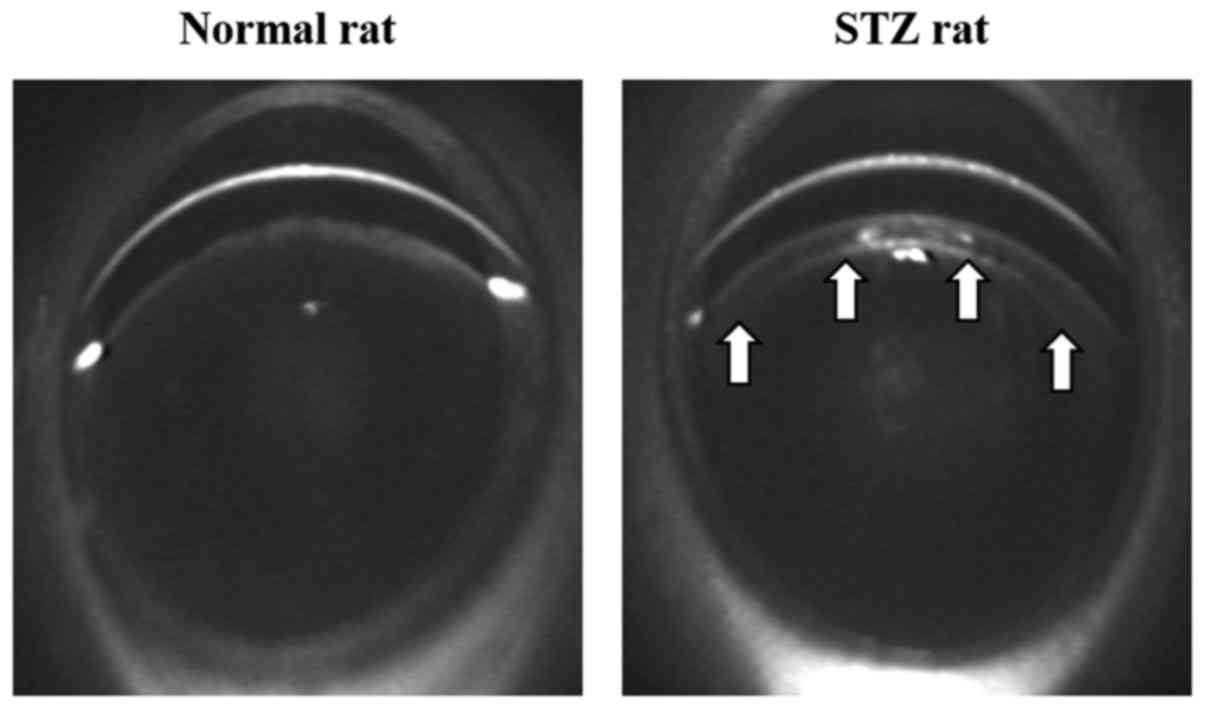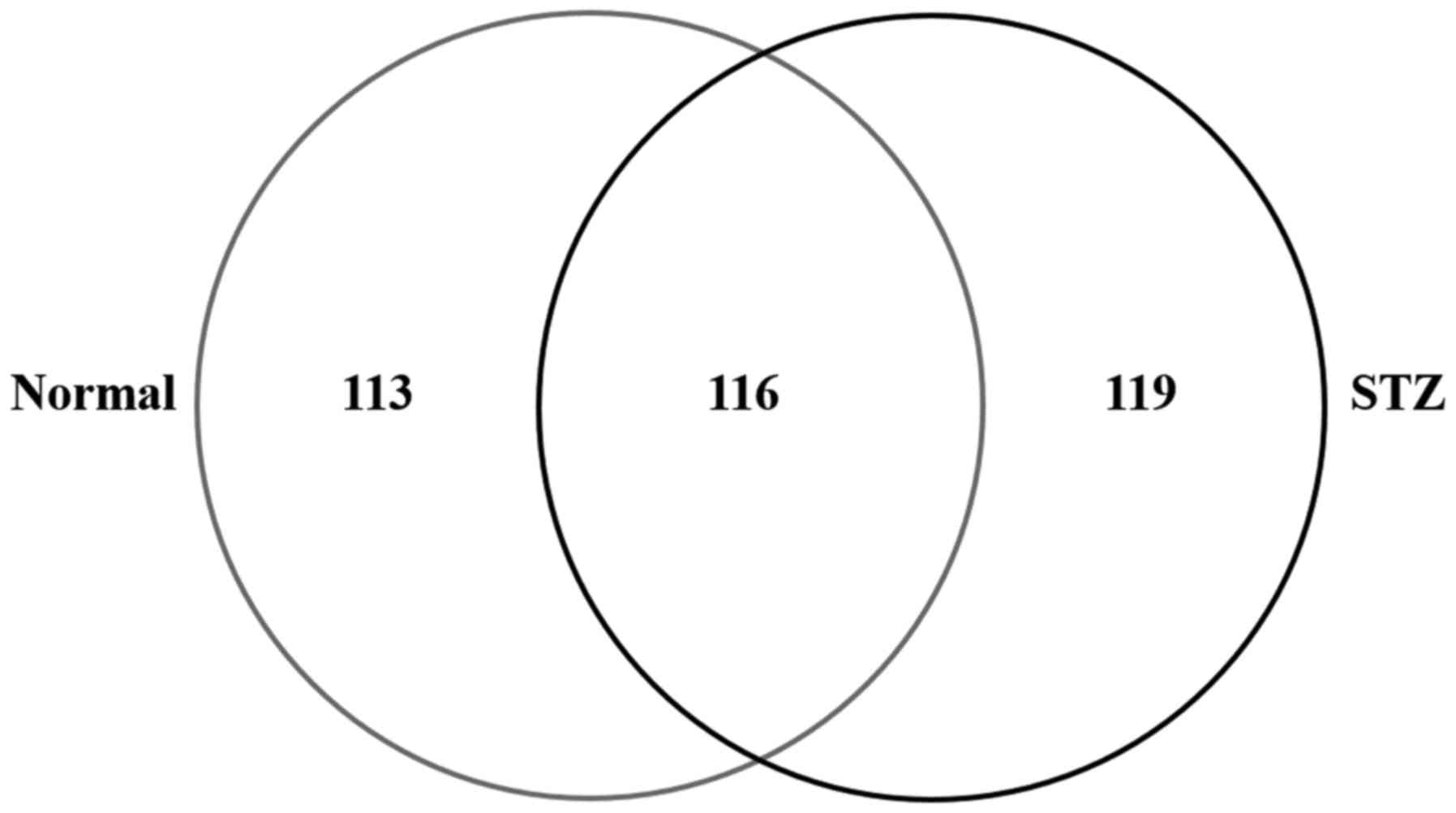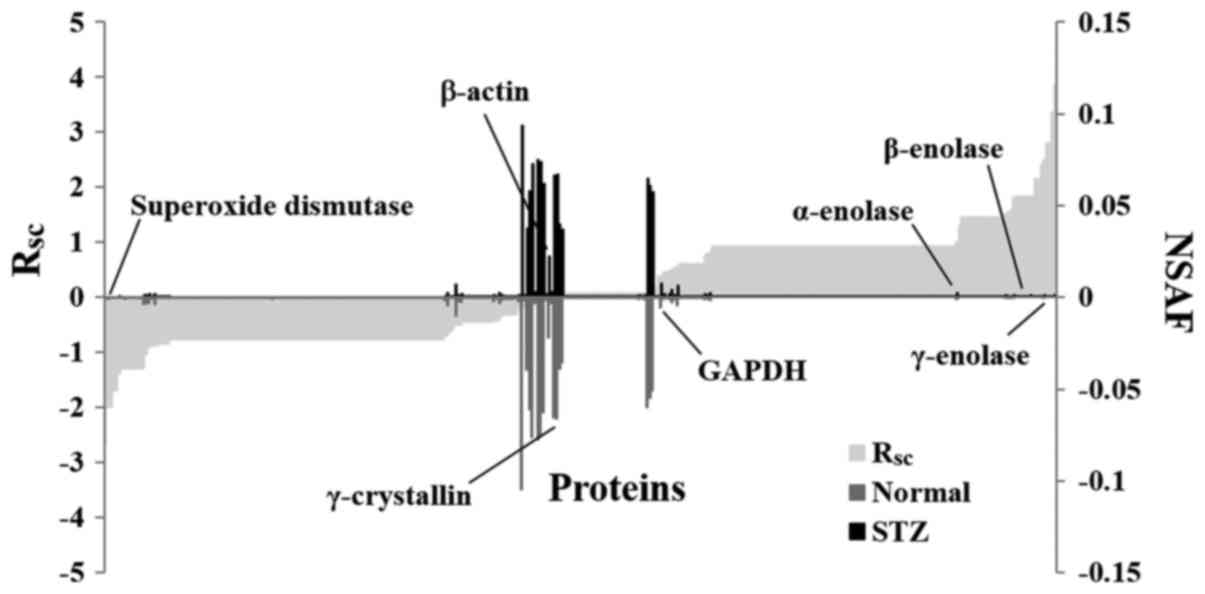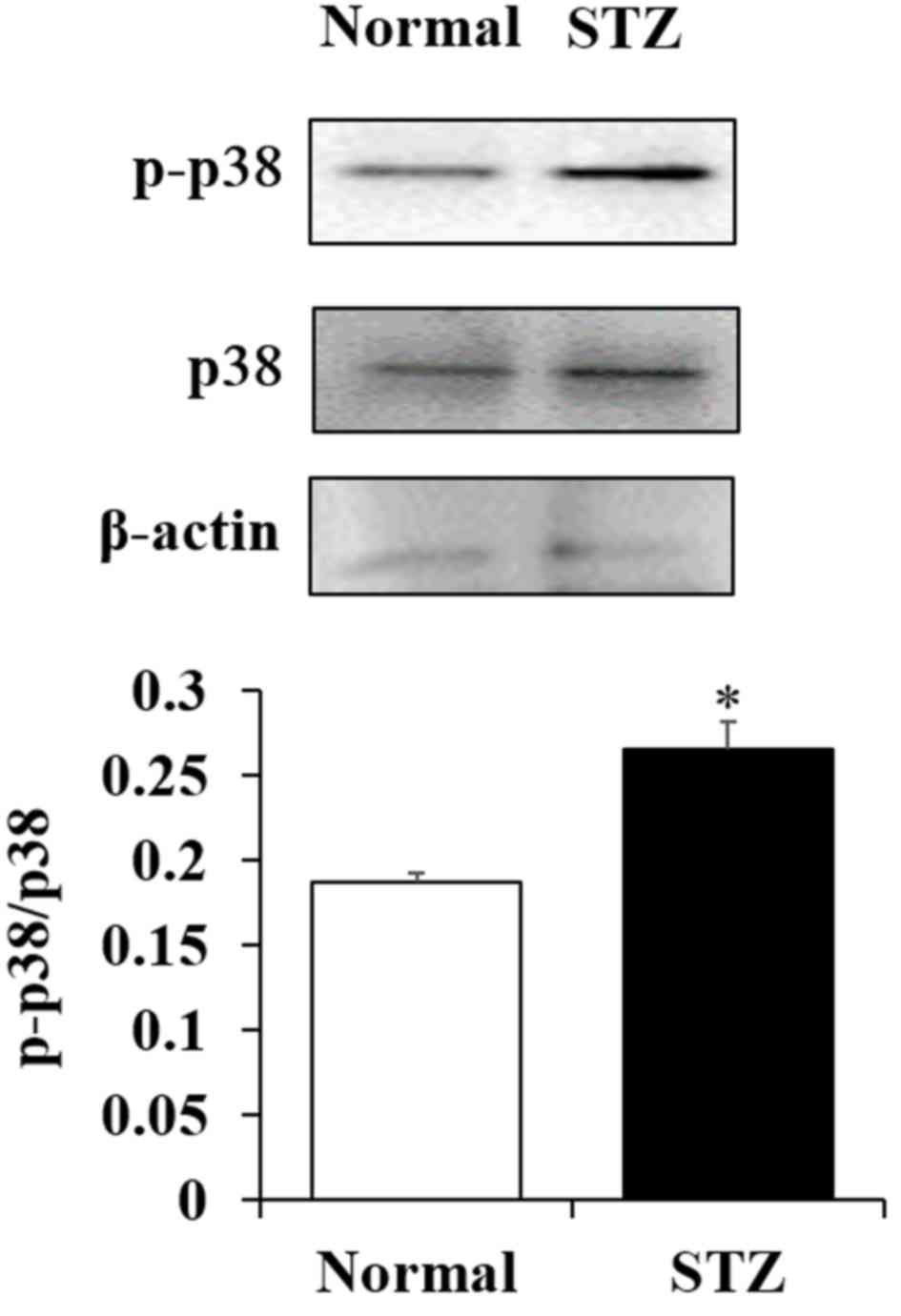|
1
|
Expert Committee on the Diagnosis and
Classification of Diabetes Mellitus, . Report of the expert
committee on the diagnosis and classification of diabetes mellitus.
Diabetes Care. 26 Suppl 1:S5–S20. 2003. View Article : Google Scholar : PubMed/NCBI
|
|
2
|
Brownlee M: Biochemistry and molecular
cell biology of diabetic complications. Nature. 414:813–820. 2001.
View Article : Google Scholar : PubMed/NCBI
|
|
3
|
Hashim Z and Zarina S: Osmotic stress
induced oxidative damage: Possible mechanism of cataract formation
in diabetes. J Diabetes Complications. 26:275–279. 2012. View Article : Google Scholar : PubMed/NCBI
|
|
4
|
Srivastava SK, Ramana KV and Bhatnagar A:
Role of aldose reductase and oxidative damage in diabetes and the
consequent potential for therapeutic options. Endocr Rev.
26:380–392. 2005. View Article : Google Scholar : PubMed/NCBI
|
|
5
|
Ahmed N: Advanced glycation endproducts -
role in pathology of diabetic complications. Diabetes Res Clin
Pract. 67:3–21. 2005. View Article : Google Scholar : PubMed/NCBI
|
|
6
|
Araki N, Ueno N, Chakrabarti B, Morino Y
and Horiuchi S: Immunochemical evidence for the presence of
advanced glycation end products in human lens proteins and its
positive correlation with aging. J Biol Chem. 267:10211–10214.
1992.PubMed/NCBI
|
|
7
|
Duhaiman AS: Glycation of human lens
proteins from diabetic and (nondiabetic) senile cataract patients.
Glycoconj J. 12:618–621. 1995. View Article : Google Scholar : PubMed/NCBI
|
|
8
|
Lyons TJ, Silvestri G, Dunn JA, Dyer DG
and Baynes JW: Role of glycation in modification of lens
crystallins in diabetic and nondiabetic senile cataracts. Diabetes.
40:1010–1015. 1991. View Article : Google Scholar : PubMed/NCBI
|
|
9
|
Nagaraj RH, Sell DR, Prabhakaram M,
Ortwerth BJ and Monnier VM: High correlation between pentosidine
protein crosslinks and pigmentation implicates ascorbate oxidation
in human lens senescence and cataractogenesis. Proc Natl Acad Sci
USA. 88:pp. 10257–10261. 1991; View Article : Google Scholar : PubMed/NCBI
|
|
10
|
Shamsi FA, Sharkey E, Creighton D and
Nagaraj RH: Maillard reactions in lens proteins:
Methylglyoxal-mediated modifications in the rat lens. Exp Eye Res.
70:369–380. 2000. View Article : Google Scholar : PubMed/NCBI
|
|
11
|
Agte VV and Tarwadi KV: Combination of
diabetes and cataract worsens the oxidative stress and
micronutrient status in Indians. Nutrition. 24:617–624. 2008.
View Article : Google Scholar : PubMed/NCBI
|
|
12
|
Jeganathan VS, Wang JJ and Wong TY: Ocular
associations of diabetes other than diabetic retinopathy. Diabetes
Care. 31:1905–1912. 2008. View Article : Google Scholar : PubMed/NCBI
|
|
13
|
Ookawara T, Kawamura N, Kitagawa Y and
Taniguchi N: Site-specific and random fragmentation of Cu,
Zn-superoxide dismutase by glycation reaction. Implication of
reactive oxygen species. J Biol Chem. 267:18505–18510.
1992.PubMed/NCBI
|
|
14
|
Kinoshita JH: Mechanisms initiating
cataract formation. Proctor Lecture. Invest Ophthalmol. 13:713–724.
1974.PubMed/NCBI
|
|
15
|
Kinoshita JH: Cataracts in galactosemia.
The Jonas S. Friedenwald Memorial Lecture. Invest Ophthalmol.
4:786–799. 1965.PubMed/NCBI
|
|
16
|
Pollreisz A and Schmidt-Erfurth U:
Diabetic cataract-pathogenesis, epidemiology and treatment. J
Ophthalmol. 2010:6087512010. View Article : Google Scholar : PubMed/NCBI
|
|
17
|
Takamura Y, Sugimoto Y, Kubo E, Takahashi
Y and Akagi Y: Immunohistochemical study of apoptosis of lens
epithelial cells in human and diabetic rat cataracts. Jpn J
Ophthalmol. 45:559–563. 2001. View Article : Google Scholar : PubMed/NCBI
|
|
18
|
Li WC, Kuszak JR, Dunn K, Wang RR, Ma W,
Wang GM, Spector A, Leib M, Cotliar AM, Weiss M, et al: Lens
epithelial cell apoptosis appears to be a common cellular basis for
non-congenital cataract development in humans and animals. J Cell
Biol. 130:169–181. 1995. View Article : Google Scholar : PubMed/NCBI
|
|
19
|
Tang WH, Martin KA and Hwa J: Aldose
reductase, oxidative stress, and diabetic mellitus. Front
Pharmacol. 3:872012. View Article : Google Scholar : PubMed/NCBI
|
|
20
|
Stitt AW: The maillard reaction in eye
diseases. Ann N Y Acad Sci. 1043:582–597. 2005. View Article : Google Scholar : PubMed/NCBI
|
|
21
|
Ivorra MD, Payá M and Villar A: A review
of natural products and plants as potential antidiabetic drugs. J
Ethnopharmacol. 27:243–275. 1989. View Article : Google Scholar : PubMed/NCBI
|
|
22
|
Irudayaraj S Stephen, Sunil C,
Duraipandiyan V and Ignacimuthu S: Antidiabetic and antioxidant
activities of Toddalia asiatica (L.) Lam. leaves in streptozotocin
induced diabetic rats. J Ethnopharmacol. 143:515–523. 2012.
View Article : Google Scholar : PubMed/NCBI
|
|
23
|
Nisha P and Mini S: Flavanoid rich ethyl
acetate fraction of Musa paradisiaca inflorescence down-regulates
the streptozotocin induced oxidative stress, hyperglycaemia and
mRNA levels of selected inflammatory genes in rats. J Funct Foods.
5:1838–1847. 2013. View Article : Google Scholar
|
|
24
|
Nagai N, Ito Y and Sasaki H: Hyperglycemia
enhances the production of amyloid β1–42 in the lenses of Otsuka
Long-Evans Tokushima fatty rats, a model of human type 2 diabetes.
Invest Ophthalmol Vis Sci. 57:1408–1417. 2016. View Article : Google Scholar : PubMed/NCBI
|
|
25
|
Bluemlein K and Ralser M: Monitoring
protein expression in whole-cell extracts by targeted label- and
standard-free LC-MS/MS. Nat Protoc. 6:859–869. 2011. View Article : Google Scholar : PubMed/NCBI
|
|
26
|
Old WM, Meyer-Arendt K, Aveline-Wolf L,
Pierce KG, Mendoza A, Sevinsky JR, Resing KA and Ahn NG: Comparison
of label-free methods for quantifying human proteins by shotgun
proteomics. Mol Cell Proteomics. 4:1487–1502. 2005. View Article : Google Scholar : PubMed/NCBI
|
|
27
|
Zybailov B, Coleman MK, Florens L and
Washburn MP: Correlation of relative abundance ratios derived from
peptide ion chromatograms and spectrum counting for quantitative
proteomic analysis using stable isotope labeling. Anal Chem.
77:6218–6224. 2005. View Article : Google Scholar : PubMed/NCBI
|
|
28
|
Lundgren DH, Hwang SI, Wu L and Han DK:
Role of spectral counting in quantitative proteomics. Expert Rev
Proteomics. 7:39–53. 2010. View Article : Google Scholar : PubMed/NCBI
|
|
29
|
Yamamoto T, Kudo M, Peng WX and Naito Z:
Analysis of protein expression regulated by lumican in PANC 1 cells
using shotgun proteomics. Oncol Rep. 30:1609–1621. 2013. View Article : Google Scholar : PubMed/NCBI
|
|
30
|
Takaya A, Peng WX, Ishino K, Kudo M,
Yamamoto T, Wada R, Takeshita T and Naito Z: Cystatin B as a
potential diagnostic biomarker in ovarian clear cell carcinoma. Int
J Oncol. 46:1573–1581. 2015. View Article : Google Scholar : PubMed/NCBI
|
|
31
|
Kanzaki A, Kudo M, Ansai S, Peng WX,
Ishino K, Yamamoto T, Wada R, Fujii T, Teduka K, Kawahara K, et al:
Insulin-like growth factor 2 mRNA-binding protein-3 as a marker for
distinguishing between cutaneous squamous cell carcinoma and
keratoacanthoma. Int J Oncol. 48:1007–1015. 2016. View Article : Google Scholar : PubMed/NCBI
|
|
32
|
Yamamoto T, Kudo M, Peng WX, Takata H,
Takakura H, Teduka K, Fujii T, Mitamura K, Taga A, Uchida E and
Naito Z: Identification of aldolase A as a potential diagnostic
biomarker for colorectal cancer based on proteomic analysis using
formalin-fixed paraffin-embedded tissue. Tumour Biol.
37:13595–13606. 2016. View Article : Google Scholar : PubMed/NCBI
|
|
33
|
Takata H, Kudo M, Yamamoto T, Ueda J,
Ishino K, Peng WX, Wada R, Taniai N, Yoshida H, Uchida E and Naito
Z: Increased expression of PDIA3 and its association with cancer
cell proliferation and poor prognosis in hepatocellular carcinoma.
Oncol Lett. 12:4896–4904. 2016.PubMed/NCBI
|
|
34
|
Kawamura T, Nomura M, Tojo H, Fujii K,
Hamasaki H, Mikami S, Bando Y, Kato H and Nishimura T: Proteomic
analysis of laser-microdissected paraffin-embedded tissues: (1)
Stage-related protein candidates upon non-metastatic lung
adenocarcinoma. J Proteomics. 73:1089–1099. 2010. View Article : Google Scholar : PubMed/NCBI
|
|
35
|
Quinlan RA, Sandilands A, Procter JE,
Prescott AR, Hutcheson AM, Dahm R, Gribbon C, Wallace P and Carter
JM: The eye lens cytoskeleton. Eye (Lond). 13(Pt 3b): 1–416.
1999.PubMed/NCBI
|
|
36
|
Maurya OP, Mohanty L, Bhaduri G and
Chandra A: Role of anti-oxidant enzymes superoxide dismutase and
catalase in the development of cataract: Study of serum levels in
patients with senile and diabetic cataracts. J Indian Med Assoc.
104:394, 396–397. 2006.
|













